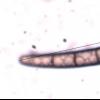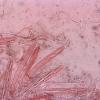
21-12-2025 09:32
Hello.A tiny ascomycete found embedded in wood in

22-12-2025 00:47
Patrice TANCHAUDBonsoir, récolte à proximité du milieu dunaire

21-12-2025 21:32
Pol DebaenstHello, Garden, Burgweg 19, Veurne, BelgiumOn 10/1

21-12-2025 21:40
Isabelle CharissouBonjour, j'aimerais connaitre les références de

21-12-2025 21:31
Pol DebaenstHello, Garden, Burgweg 19, Veurne, BelgiumOn 10/1

21-12-2025 21:31
Pol DebaenstHello, Garden, Burgweg 19, Veurne, BelgiumOn 10/1

20-12-2025 23:08
Patrice TANCHAUDBonsoir, récolte sur sol sablonneux dans l'arri�

20-12-2025 15:47
Mirek GrycHi.These grew on pine wood that was heavily covere
Geoglossum
Malcolm Greaves,
13-11-2015 13:36
Would this be within a reasonable range for the species or is there another species I should be looking at?
Thanks
Mal
Michael Beug,
14-11-2015 01:33

Re : Geoglossum umbratile
Geoglossum umbratile spore size is highly variable (30-90 x 4.5-6.5 microns). The septa in the paraphyses are not constricted while the septa in Geoglossum simile and G. pygmaeum both are constricted. Geoglossum simile and Geoglossum glabrum have paraphyses that are closely septate in the upper portions.
Sabino Arauzo,
15-11-2015 12:40
Re : Geoglossum
The asci, paraphyses and inmature spores guttulation are typical of G. fallax, but shorter spores, as HB6543 of Zotto!
Regards.
Sabino.
Malcolm Greaves,
15-11-2015 21:26
Re : Geoglossum
Thanks Michael and Sabino.
Looking at Zotto's great descriptions I think that as I could find no mature spores with more than 7 septae and the paraphyses were quite swollen I think G umbratile is more likely. I will note for future that the spores can be more variable than some descriptions say.
Mal
Looking at Zotto's great descriptions I think that as I could find no mature spores with more than 7 septae and the paraphyses were quite swollen I think G umbratile is more likely. I will note for future that the spores can be more variable than some descriptions say.
Mal
Iglesias Plácido,
16-11-2015 12:31
Re : Geoglossum
Geoglossum fallax típico.
Malcolm Greaves,
16-11-2015 16:09
Re : Geoglossum
Hi Iglesias
I have very little experience of Geoglossum so if this is typical G fallax what differences should I look out for in G umbratile?
Thanks
Mal
I have very little experience of Geoglossum so if this is typical G fallax what differences should I look out for in G umbratile?
Thanks
Mal
Michael Beug,
16-11-2015 18:34

Re : Geoglossum
My understanding of Geoglossum fallax is that it is notable for its brown rather than black fertile surface color, a finely scaly stipe, gnerally hyaline spores that only tardily become septate and turn smoky, The spores are initially non-septate, then 3-septate and finally 7-12 septa. Paraphyses are 5-6 microns, cylindric, sparingly to moderately septate, not constricted or only moderately constricted at the septa and strongly curved or coiled in the upper part. The paraphyses are very similar to those of G. umbratile. Some collections of G. umbratile are viscid. G. umbratile fruitbodies are dark brown to black




